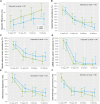Longitudinal comparison of dyssynchrony correction and 'strain' improvement by conduction system pacing: LEVEL-AT trial secondary findings
- PMID: 38768299
- PMCID: PMC11441034
- DOI: 10.1093/ehjci/jeae132
Longitudinal comparison of dyssynchrony correction and 'strain' improvement by conduction system pacing: LEVEL-AT trial secondary findings
Abstract
Aims: Longitudinal dyssynchrony correction and 'strain' improvement by comparable cardiac resynchronization therapy (CRT) techniques is unreported. Our purpose was to compare echocardiographic dyssynchrony correction and 'strain' improvement by conduction system pacing (CSP) vs. biventricular pacing (BiVP) as a marker of contractility improvement during 1-year follow-up.
Methods and results: A treatment-received analysis was performed in patients included in the LEVEL-AT trial (NCT04054895), randomized to CSP or BiVP, and evaluated at baseline (ON and OFF programming) and at 6 and 12 months (n = 69, 32% women). Analysis included intraventricular (septal flash), interventricular (difference between left and right ventricular outflow times), and atrioventricular (diastolic filling time) dyssynchrony and 'strain' parameters [septal rebound, global longitudinal 'strain' (GLS), LBBB pattern, and mechanical dispersion). Baseline left ventricular ejection fraction (LVEF) was 27.5 ± 7%, and LV end-systolic volume (LVESV) was 138 ± 77 mL, without differences between groups. Longitudinal analysis showed LVEF and LVESV improvement (P < 0.001), without between-group differences. At 12-month follow-up, adjusted mean LVEF was 46% with CSP (95% CI 42.2 and 49.3%) vs. 43% with BiVP (95% CI 39.6 and 45.8%), (P = 0.31), and LVESV was 80 mL (95% CI 55.3 and 104.5 mL) vs. 100 mL (95% CI 78.7 and 121.6 mL), respectively (P = 0.66). Longitudinal analysis showed a significant improvement of all dyssynchrony parameters and GLS over time (P < 0.001), without differences between groups. Baseline GLS significantly correlated with LVEF and LVESV at 12-month follow-up.
Conclusion: CSP and BiVP provided similar dyssynchrony and 'strain' correction over time. Baseline global longitudinal 'strain' predicted ventricular remodelling at 12-month follow-up.
Keywords: biventricular pacing; conduction system pacing; dyssynchrony; global longitudinal ‘strain’; left bundle branch pacing; resynchronization therapy; ‘strain’.
© The Author(s) 2024. Published by Oxford University Press on behalf of the European Society of Cardiology.
Conflict of interest statement
Conflict of interest: M.P.-L. has received speaker honoraria from Medtronic. J.M.T. has received honoraria as a lecturer and consultant from Abbott, Boston Scientific, and Medtronic. L.M. has received unrestricted research grants, fellowship programme support, and honoraria as a lecturer and consultant from Abbott, Biotronik, Boston Scientific, Livanova, and Medtronic; he holds stock in Galgo Medical and Corify. I.R.-L. has received honoraria as a lecturer and consultant from Abbott and Biosense Webster. M.S. has received consultant fees and speaker honoraria from Abbott, Medtronic, General Electric, and Edwards Lifesciences. M.A.C. has received speaker honoraria from Boston Scientific, Abbott, and Microport. E.A. has received speaker honoraria from Biosense Webster and Bayer. A.P.-S. has received honoraria as a lecturer and consultant from Biosense Webster, Abbott, and Boston Scientific. All remaining authors have declared no conflicts of interest.
Figures






References
-
- Glikson M, Nielsen JC, Kronborg MB, Michowitz Y, Auricchio A, Barbash IMet al. . 2021 ESC guidelines on cardiac pacing and cardiac resynchronization therapy. EP Europace 2022;24:71–164. - PubMed
-
- Vijayaraman P, Sharma PS, Cano Ó, Ponnusamy SS, Herweg B, Zanon Fet al. . Comparison of left bundle branch area pacing and biventricular pacing in candidates for resynchronization therapy. J Am Coll Cardiol 2023;82:228–41. - PubMed
Publication types
MeSH terms
Grants and funding
LinkOut - more resources
Full Text Sources
Research Materials
Miscellaneous

